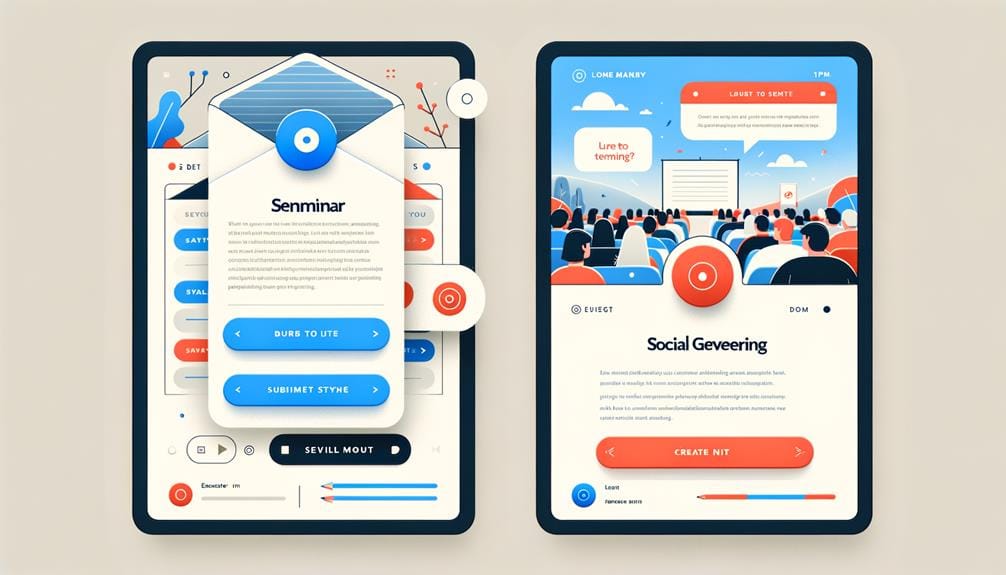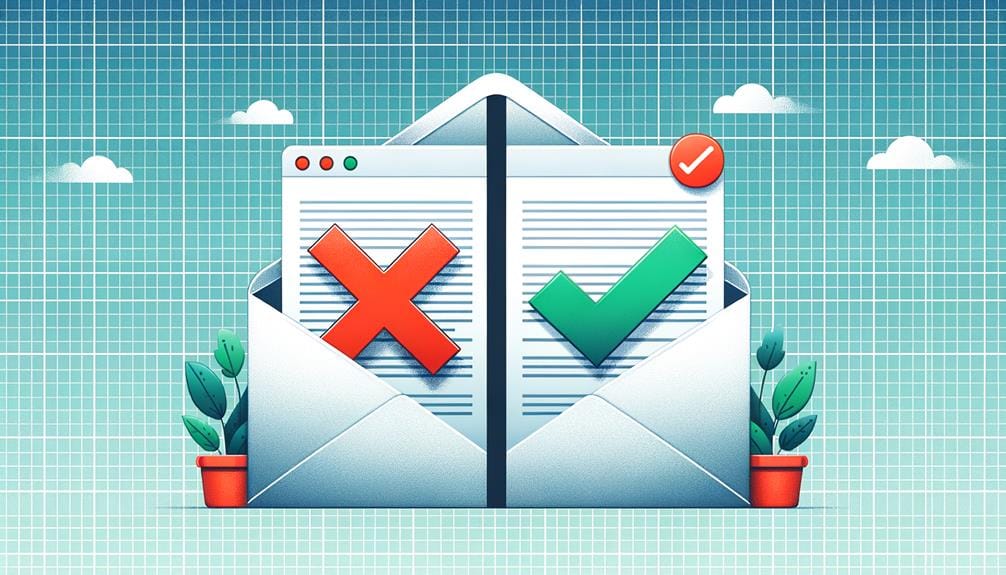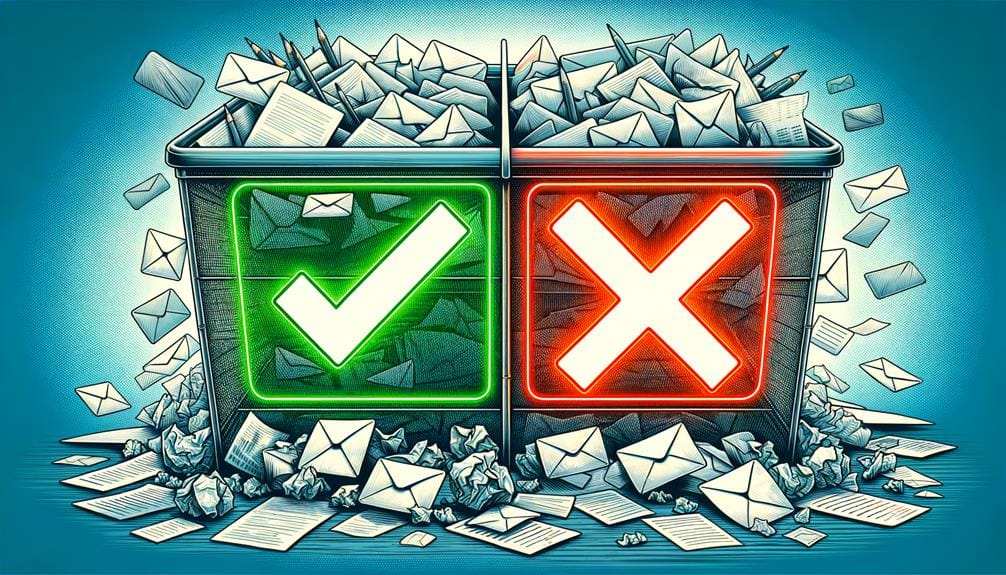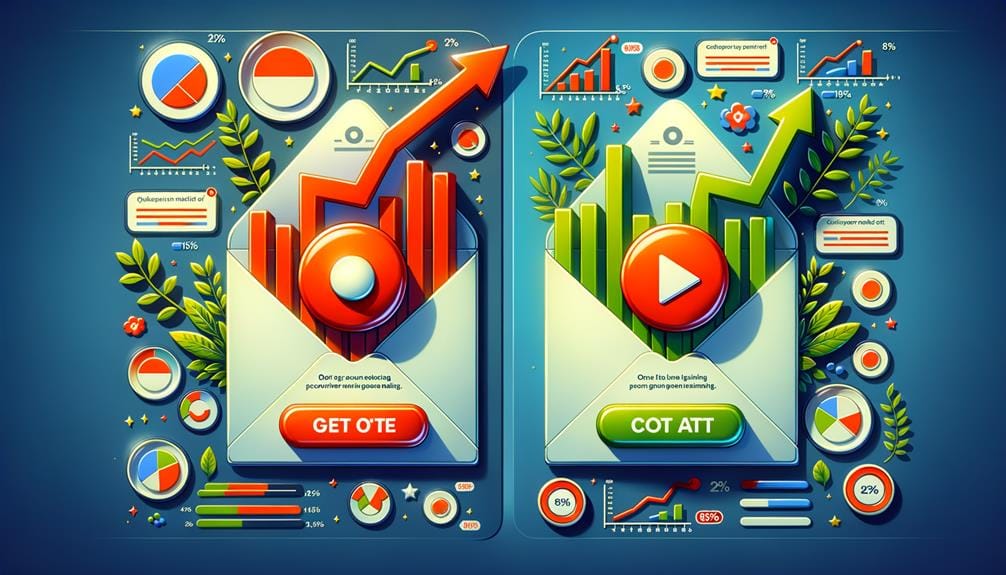To boost your email campaigns, you can use proven A/B testing techniques that increase open rates by up to 49% and click-through rates by 161%. Start by testing essential elements like subject lines, sender names, and email content, including visuals, copy length, and CTAs. Clearly define what you’re testing and the expected outcome, using data-driven insights to inform your hypotheses. Use top tools like ActiveCampaign, Mailchimp, or HubSpot to streamline your testing process. By following best practices and avoiding common mistakes, you can refine your strategy and drive significant improvements – and that’s just the beginning of optimizing your email campaign success.
Benefits of A/B Testing Emails
By incorporating A/B testing into your email campaigns, you can greatly enhance their effectiveness, achieving noticeable improvements in key metrics such as open rates, click-through rates, and conversion rates. You’ll be surprised at how a simple tweak can lead to a 49% increase in open rates and a 161% increase in click-through rates.
Personalizing subject lines through A/B testing can result in a 26% higher unique open rate, making it clear that tailored content resonates with readers.
But that’s not all – A/B testing emails can also increase conversion rates by 49% on average. Additionally, emails with personalized sender names from A/B testing see a whopping 760% increase in revenue.
By optimizing your email campaigns through A/B testing, you can expect a 75% boost in engagement metrics. This data-driven approach allows you to refine your strategy, making informed decisions to drive results.
Essential Elements to Test First

Now that you’ve seen the potential of A/B testing to boost your email campaigns’ effectiveness, it’s time to focus on the specific elements that will give you the biggest impact for your investment – starting with the ones that make the first impression.
Begin by testing subject lines, as they greatly influence email engagement and open rates. Try out different sender names to see if personalization or company branding boosts trust and interaction with your subscribers.
Next, experiment with email content elements like visuals, copy length, and CTAs to enhance user engagement. Don’t forget to evaluate the impact of preheader text on open rates, considering questions, urgency, or automation triggers to grab attention.
Finally, explore interactive content options like surveys or quizzes to increase subscriber interaction and engagement. By testing these essential elements, you’ll be able to refine your A/B testing email strategy and create more effective campaigns that drive real results.
Crafting Effective A/B Testing Hypotheses

Your A/B testing strategy relies heavily on crafting effective hypotheses that clearly identify the specific elements you want to test and the expected outcomes of those tests. In email testing, a well-crafted hypothesis is vital for guiding the testing process and informing decision-making.
When creating a hypothesis for A/B testing in email marketing, consider the key metrics you want to impact, such as open rates or click-through rates.
To craft a solid hypothesis, focus on the following:
- Clearly define the element you want to test, such as subject lines or sender names
- Identify the expected outcome of changing the tested element
- Use data-driven insights to inform your hypothesis
- Align your hypothesis with industry best practices
A good hypothesis will help you measure the impact of changes on your email campaign performance. For instance, ‘Changing the subject line to include emojis will increase the open rate by 10%.’
Top Tools for A/B Testing Success

With a well-crafted hypothesis in place, you’re ready to put your A/B testing strategy into action, and the right tools can make all the difference in achieving successful email campaigns. When it comes to email A/B testing, you’ll want to utilize high-quality testing tools that seamlessly integrate with your email marketing strategy.
ActiveCampaign, Mailchimp, HubSpot, Sendinblue, and GetResponse are leading the charge, offering a range of A/B testing capabilities that cater to your unique needs.
These innovative tools enable you to test email subject lines, sender details, and content design, as well as email layouts, call-to-action buttons, and personalization elements. By leveraging these features, you’ll be able to improve your email campaigns, boost engagement rates, and drive conversions.
Whether you’re looking to optimize send times, content variations, or sender information, these tools have got you covered. By incorporating A/B testing best practices into your email marketing strategy, you’ll be well on your way to creating high-performing campaigns that deliver results.
Best Practices for Accurate Results

To secure the reliability of your A/B testing results, following best practices that minimize bias and maximize data accuracy is pivotal. When it comes to email campaigns, you want to make sure that your tests are yielding dependable results that inform your future decisions.
To achieve this, keep the following best practices in mind:
- Use a large sample size to secure statistical significance.
- Test one variable at a time to precisely attribute performance changes.
- Wait for sufficient time before evaluating results to allow for meaningful engagement data.
- Limit the number of variations to test to secure the reliability of the outcomes.
Common Mistakes to Avoid Testing

While best practices can guide you in achieving dependable A/B testing results, being aware of common mistakes to avoid will further safeguard the integrity of your tests and the decisions that follow.
You’ll want to steer clear of testing multiple variables at once, as this can lead to inconclusive results and make it difficult to pinpoint the impact of each change. It’s also essential to make data-driven decisions rather than relying on personal preferences.
Don’t overlook the importance of segmenting your audience properly before conducting A/B tests, as this will guarantee accurate and relevant results.
Avoid prematurely ending tests before reaching statistical significance, as this may lead to making decisions based on incomplete data. Another crucial mistake to avoid is neglecting to document and analyze the results of unsuccessful A/B tests, as these provide valuable insights for future campaign improvements.
Analyzing and Implementing Test Results

Now that you’ve run your A/B tests, it’s time to make sense of the results and put your findings into action. Analyzing your test outcomes helps you identify which elements – like subject lines, CTAs, or visuals – truly resonate with your audience, so you can refine your strategy.
Understanding Test Outcomes
Analyzing the outcomes of your A/B tests is crucial, as it’s through these results that you’ll uncover the insights needed to refine your email campaigns and boost engagement.
To make data-driven decisions, you need to interpret the test outcomes accurately, taking into account statistical significance. By analyzing key metrics like open rates, click-through rates, and conversions, you’ll identify which elements of your email campaigns are working and which need improvement.
When evaluating test outcomes, consider the following:
- Keep an eye on confidence levels to make certain your results are statistically significant (typically 95% or higher).
- Look for clear winners that outperform the control group.
- Consider segmenting your results to identify how different groups responded to the test.
- Don’t get too hung up on metrics that aren’t the primary goal of the test.
Implementing Winning Variations
With your A/B test results in hand, it’s essential to swiftly implement the winning variations that have proven to boost engagement and conversions in your email campaigns. Analyze the data to identify which subject lines, personalized content, and strategic CTAs drove the highest open rates, click-through rates, and conversions. Use these insights to refine your email marketing strategy and tailor your messages to subscriber preferences.
Implementing winning variations is key to maximizing the effectiveness of your email marketing efforts. By applying the learnings from your A/B testing, you can enhance engagement and drive better results in your email campaigns.
For instance, if your test reveals that a specific subject line or CTA button color drove higher conversions, incorporate those elements into your future campaigns.
Refining Future Campaigns
To maximize the impact of your A/B testing efforts, you must carefully evaluate the results and use the data-driven insights to inform and refine your future email campaigns. Analyzing A/B test results helps you identify patterns and trends in email performance, such as open rates and click-through rates. This process enables you to pinpoint areas for optimization, ultimately boosting engagement and conversion rates.
By leveraging data-driven insights, you can refine various email elements, including:
- Subject lines that resonate with your target audience
- Visuals that enhance the overall user experience
- CTAs that drive meaningful interactions
- Sender information that establishes trust
As you continuously monitor and adjust your email strategies based on A/B test findings, you’ll improve overall campaign effectiveness. By implementing successful test variations and tailoring your email content, you’ll be better equipped to captivate your audience and drive desired results.
Maximizing ROI With A/B Testing

By incorporating A/B testing into your email campaigns, you can reveal significant returns on investment, boosting open rates by up to 49% and click-through rates by as much as 161%. This is especially true when you focus on high-impact elements like subject lines, personalization, and call-to-action buttons.
Here are some A/B testing statistics that’ll grab your attention:
| Tested Element | Impact on Open Rates | Impact on Click-Through Rates |
|---|---|---|
| Subject Lines | Up to 24% improvement | – |
| Personalization | 29% increase | – |
| Call-to-Action Buttons | – | Over 90% boost |
| Visuals | 5-10% increase | 5-15% increase |
| Copy | 10-20% increase | 10-25% increase |
These numbers demonstrate the power of A/B testing in maximizing ROI. By testing and refining your email campaigns, you can drive significant improvements in both open rates and click-through rates. Whether you’re tweaking subject lines, personalizing sender names, or experimenting with different CTAs, the key is to test, analyze, and optimize. So, get creative with your email campaigns and start testing your way to higher returns on investment.
To Recap
As a master chef tweaks a secret recipe, you fine-tune your email campaigns through A/B testing. With each variation, you uncover the perfect blend of components – subject lines, CTAs, and sender names – that drive results.
By applying the techniques outlined here, you’ll transform your email campaigns from bland to grand, serving up higher opens, clicks, and conversions.
Continue testing, analyzing, and refining to guarantee your emails remain a recipe for success.








